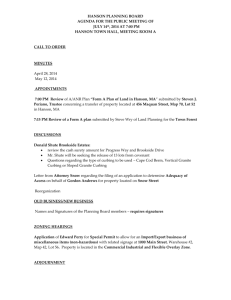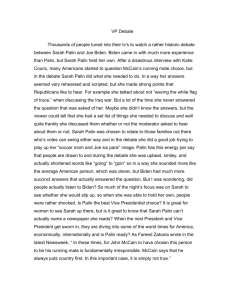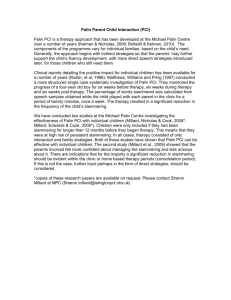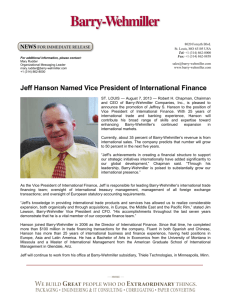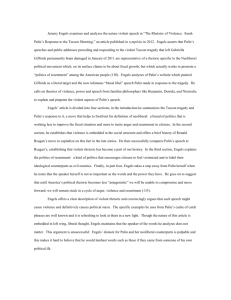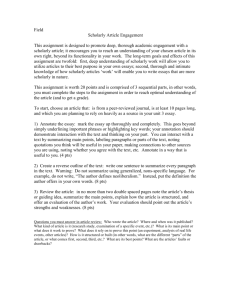'Pitbulls' and Populist Politicians: Sarah Palin, Pauline
advertisement
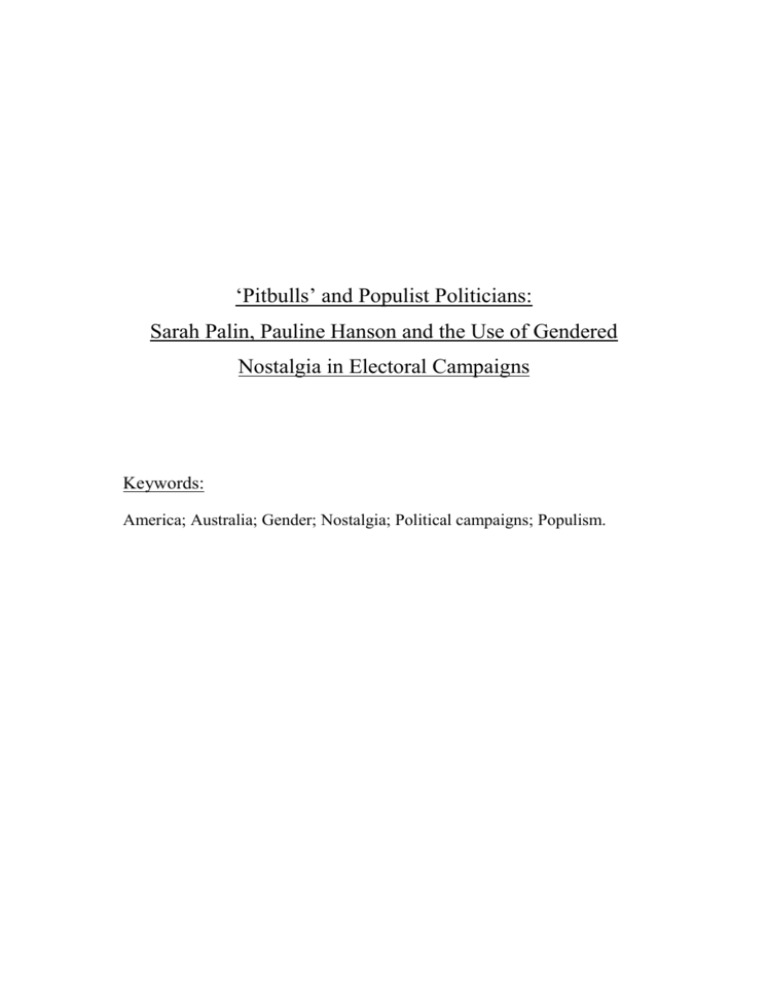
‘Pitbulls’ and Populist Politicians: Sarah Palin, Pauline Hanson and the Use of Gendered Nostalgia in Electoral Campaigns Keywords: America; Australia; Gender; Nostalgia; Political campaigns; Populism. Sarah Palin and Pauline Hanson were charismatic and populist politicians, whose home states of Alaska and Queensland became central to their political narrative. Both women gained political influence at times of intense debate regarding their respective countries’ national identities. Voters perceived the states to be locales that evoked antiestablishment authenticity, and which echoed the historical dynamism of frontier society. The women used this association to consolidate their call for social renewal that would return politics to sections of the citizenry who felt themselves to be marginalized. The women’s authority was augmented by gendered stereotypes that directed attention to their apparent vulnerability and honesty in attempting public service. Although their messages were calibrated differently, Palin and Hanson both demanded moral and political renewal, and generated intense support through their sexualized rhetoric of economic security and social nostalgia. ‘What’s the difference between a pitbull and a hockey mom? Lipstick’ (Palin, 4 September 2008). Sarah Palin’s statement positioned her as an antiestablishment politician with a flair for egalitarian rhetoric. Over ten years earlier, the Australian politician Pauline Hanson had occupied a similar position, based on her appeal as a woman outside the political establishment who evoked memories of Australia’s settler society. Her message continues to resonate, and in 2009 professional photographer Emma Phillips depicted Hanson scrubbing Australian flags clean in the setting of a mid-century rural farm (Phillips Online Gallery). Both women’s political successes relied on their ability to evoke Alaska and Queensland’s position in their respective national imaginations, where the two states’ rugged locales were traditionally associated with masculine frontier values. This paper demonstrates that Hanson and Palin’s political careers both relied on the integration of gendered appeal with nostalgic memories of settler societies, creating a credible message of social renewal and political differentiation. There is an established body of scholarly literature that compares American and Australian political culture. This is relatively unsurprising, given both Australia and the United States share comparable traditions of settler societies. Moreover, the citizens of both countries generally respond positively to imagery that evokes an idealized frontier past. Yet scholars, such as Louis Hartz (1964), have argued that the countries’ shared European heritage has been experienced differently. Hartz suggested that whilst Australian public culture derived predominantly from British radicalism, the United States was based more broadly on liberal ideals. The ongoing comparisons in political culture have been deepened most recently by Marilyn Lake and Henry Reynold’s consideration of the importance of race to transnational political debates throughout the English-speaking world in the twentieth century (Lake and Reynolds, 2008) The position of the frontier in both American and Australian historiography has fascinated historians since the late nineteenth century ( Faragher, 1998), yet there has been comparatively little research on its contemporary impact on political populism. Scholars note that in both countries, the frontier has acquired meaning only in its relationship to rapidly expanding urban centres (Alexander, 1969). In contrast to the fluid social relations of the cities however, the frontier represents a form of moral renewal and sustainable development, which can act as a national reference point for self-sufficiency and individualism (Blainey, 1966; Ward, 1966). The frontier is reconstructed in both American and Australian popular imaginations as a site of individual control and national reassertion that is clearly differentiated from more urban identities (Russell, 2001; Furniss, 1999). Alaska and Queensland possess a number of specific cultural and political similarities that render comparisons particularly effective. Although both states are geographically vast, the majority of their territories remain uninhabited. Alaska and Queensland have promoted themselves as unspoilt wilderness, where adventure and natural beauty outstrip more elite cultural attractions. The lack of centralized political control throughout the geographically large states created similar traditions of libertarian societies, as well as a tendency for decentralized authority focused at the regional and township level. Voters sought highly personalized and responsive governments, and valued libertarian defiance of distant federal bureaucracies. The nostalgic appeal of harmonious rural communities that had been capable of dictating their own destiny was central to Hanson and Palin’s national careers. Hanson was elected as an independent in the 1996 federal election, after being disendorsed by the Queensland Liberal Party for comments regarding Aboriginal welfare claimants. She proved a resounding electoral success in her electorate of Oxley, and capitalized on media exposure by establishing the One Nation Party. Prior to its collapse, the party dominated the Australian political agenda, and successfully garnered over one million votes at the expense of the Coalition and Labor parties in the 1998 federal election. Hanson’s presence polarized the Australian electorate, resonating most successfully amongst those Australians who felt pressured by the sweeping socio-economic changes in contemporary Australia. Similarly, Palin burst onto the political scene from outside the political establishment. After serving as the Mayor of Wasilla, she ran unsuccessfully for the Republican nomination for Alaskan Lieutenant-Governor in 2002. Although she failed to be nominated, the Republican governor appointed her to the Alaska Oil and Gas Conservation Commission. Palin used her position to criticise the allegedly corrupt administration of the incumbent governor. After seizing the Republican gubernatorial nomination and her election in 2006, Palin became known as a populist, who avoided sweeping policy initiatives and favoured a limited role for government (Cobain, 2008). In 2008, her reputation as a maverick outsider was solidified by her surprise selection as the vice-presidential nominee for the Republican Party. Lambasted by the media, like Hanson, Palin nonetheless proved capable of enervating and articulating the worries of many citizens, who felt neglected by the federal elite. Hanson and Palin’s success at the national level relied on the public’s recognition of Alaska and Queensland as sources of antiestablishment authenticity. Their supporters associated the states’ wilderness and frontier heritage with traditional moral authority that transcended the political partisanship associated with contemporary politicians. The frontier connotations and associated gender stereotypes evoked honesty and public service that further differentiated Hanson and Palin from career politicians. The women used popular nostalgia for settler and frontier values to suggest they would protect and reinvigorate the nation, and would halt the corrosive social changes threatened by urban politicians. Frontier authenticity Hanson and Palin associated themselves with public perceptions of rural Alaska and Queensland. In so doing, they created an authentic message of self-determination and national agency that contrasted sharply with distant federal politicians. Rural Alaska and Queensland were closely associated with rugged individualism and self-determination on the national stage. Evocations of frontier settlements were not solely a matter of physical distance and large stretches of empty space. References to the rural frontier prompted social memories that juxtaposed the perception of contemporary moral decadence with cohesive historical townships. Although the states’ populations were popularly characterized as backward and uneducated, images of Alaska’s frozen slopes or the Queensland Outback retained considerable romantic appeal. Hanson and Palin’s repeated emphasis on cohesive local communities distinguished them from the decadent political centre, instead associating them with moral renewal. The rural frontier invoked values of settlers’ self-reliance, masculine agency and Christian morality. The women’s rhetoric recalled proud narratives of European society and mastery of the landscape, in contrast to the fluid social relations and competing interest groups associated with contemporary politicians. Hanson was particularly supportive of traditional social hierarchy, and was sharply critical of those who propounded ‘an unfair view of history [which had] led to the impractical, discriminatory, and stupid notion of land rights’ (Hanson, 1 October 1997, 8898). Disorientated sectors of the Australian electorate responded favourably to an historical frontier that evoked myths of masculine adventure, mateship and social cohesion. This image was substantially different from the complacent images of sea, surf and modernity associated with Queensland’s rapidly expanding coastal cities. Both resource-rich Alaska and Queensland spoke to a national yearning for economic security at a time of threatening globalisation. Rather than the trope of Appalachian ‘hillbillies’ or backward Tasmanians, Alaskans and Queenslanders represented the rich resources and hardy individualism that marked the nations’ continuing narratives of European identity (Mason, 2005, 43). Despite cultural nostalgia that emphasized individual agency, both Alaska and Queensland’s political cultures have been characterized by a succession of populist politicians. Hanson and Palin appeared to offer responsive and untarnished politics as electorates increasingly hankered for a return to government for the people. Queensland Premier Joh Bjelke-Peterson had retained power from 1968 until 1987, by virtue of the enduring appeal of rightwing populism. Alaskan Senator Ted Stevens remained in office from 1968 until 2008, and the Murkowski family have represented Alaska since 1981. Although electorates remained supportive of populist administrations, there was a widespread perception that politicians no longer prioritized ‘ordinary’ citizens’ needs, fuelling widespread nostalgia for political accessibility and honesty to protect local values. Populists in Alaska and Queensland had become adept at creating the impression of equality with voters. Electorates were attuned to rhetoric that denigrated political opponents as elitists lacking real experience of local issues. Elite career-politicians were symptomatic of urban cultural decadence, and culturally distinct from the working people both women targeted. This characterisation provided local populists with an effective alternative for detailed policy, and focused voters’ anger on distant federal centres rather than complex social realities. In this manner, Palin’s folk rhetoric closely referenced the local culture of frontier individualism, despite its wider applicability and appeal. Both Hanson and Palin carefully associated themselves with local spaces in the popular imagination, in order to exploit public grievances with established politicians. For example, Palin pushed for the state capital to be moved from inaccessible Juneau to Anchorage, and took care to reference local events in her speeches. Hanson was famously comfortable to be photographed in her local fish and chip shop as a demonstration of her local commitment. A pervasive moralism underpinned the states’ individualism and disdain for federal policies. Alaskans have articulated a strong sense of rugged superiority when compared to the ‘Lower 48’ states, since it became the forty-ninth state in 1959. A similarly aggressive superciliousness was embodied in Bjelke-Peterson’s bid to be elected Australian Prime Minister in the 1987 election. His campaign focussed on his own populist appeal to voters who were opposed to the alleged social consensus existing between the federal Labor and Liberal parties. The continued presence of large numbers of evangelical Christians in rural and suburban electorates ensured that moral rhetoric of resistance to liberal cosmopolitanism remained a potent force in both Alaska and Queensland. Hanson and Palin used the states’ populist and libertarian heritages to project authentic and credible ‘common sense’ policies. Both women derived greatest electoral support from low socio-economic areas, which were under pressure from globalisation and immigration. Hanson and Palin’s careful association with local spaces differentiated them from established politicians, whom they accused of social engineering and undermining social cohesion (Hanson, 3 December 1997, 11972; Palin, 24 October 2008). The women’s small-town background provided them with credibility to empathize with voters who were fearful of economic and social change. Palin deliberately emphasized her period as Mayor of Wasilla to prove she understood voters’ needs, and to demonstrate her opposition to ‘the special interests … and the good-ol’ boys network’ (Palin, 4 September 2008). Hanson similarly used her experience as a fish and chip shop owner to contrast her business acumen with federal civil servants, deriding experiences based purely on university textbooks. Neither Alaska nor Queensland had a large population of educated elites, allowing both women to rail against intellectuals as distant objects of derision rather than integral components of local space. The women portrayed themselves as bulwarks against social engineering that had undermined cultural continuity. The nostalgia for frontier values frequently acted as a foil for their supporters to express sentiments that political correctness had pushed out of the public sphere. The recollection of a historical period redolent with images of white masculine agency helped to counter a sense of passivity and victimisation that was common amongst the women’s supporters. The women’s antipathy to political correctness reinforced their status as antiestablishment politicians who were defending individualism and constitutional rights to free speech (Ahluwalia and McCarthy, 1998, 79). Palin attacked Democrats, by juxtaposing traditional, Christian consensus with the social engineering that had proved so disruptive during the turbulent 1960s (Baldwin, 7 October 2008). Only a return to vaguely defined values of honest rural society could correct the elite’s corrosive moral influence. The women’s criticism of federal policies gained them credibility, helping them to insert themselves into local spaces that were associated with nostalgia for the frontier. The women’s distinctive lexicon became a signature method to project local values into the public sphere. Media sources were fascinated by Palin’s calculated use of phrases such as ‘doggone it’, ‘darn right’, and ‘say it ain’t so Joe’ (Palin, 3 October 2008). Much derided in the national media, nevertheless they reinforced her insistence that she was ‘going to Washington to serve the people of this country’ not established interests (BBC, 4 September 2008). Hanson had derived similar kudos amongst disengaged voters by her nervousness on camera, including her infamous ‘please explain’ response to a question regarding her alleged xenophobia (Sixty Minutes, 20 October 1996). Their deliberate disassociation from conventional political presentation ensured the women demonstrated equality with constituents and groups that were generally politically disengaged (Baldwin, 3 October 2008). Amongst those disorientated by social change, the women evoked the moral certainty required to transmit traditional community values to the political centre. Large sectors of the national public associated Alaska and Queensland with opportunity and dynamism, rather than national decline. In common with earlier politicians in the American Deep South, the women argued that welfare payments unfairly disadvantaged traditional working families (Jupp, 1998, 745; BBC, 12 October 2008). Like Hanson, Palin argued that all groups deserved equal access to the opportunities offered by the egalitarian heritage of the frontier West. Unlike Hanson, Palin did not refer directly to race, although her insinuation that Barack Obama’s policies were unAmerican prompted vitriolic support at her rallies. Clear distinctions nonetheless exist between Alaska and the Deep South. Jim Crow laws structurally disempowered Blacks in a manner that was no longer congruent with contemporary Americans’ self-perception. The fact that Palin’s husband acknowledged his Inuit heritage distanced her from accusations of racism, and further bound her to the nation’s landscape. Despite similarities, Hanson and Palin calibrated their appeal differently (Deutchman and Ellison, 2004, 33). Hanson’s populism emphasized fiscal conservatism, whilst Palin’s appeal can be more readily characterized as religious conservatism (Young, 2000, 84). There were personal reasons for this, as Hanson’s two failed marriages rendered her unappealing to the Christian right, despite later attempts to court them with pronouncements on the ‘embattled’ family unit (Hanson, 26 February 1998). In contrast, Palin derived greatest support from her commitment to the ‘family values’ of the Christian rightwing. Moreover, their attitudes to financial and economic issues were only superficially similar. Like Hanson, Palin linked her economic commentary to emotive statements about struggling families in small towns, rather than particular policies. Her message avoided detailed prescriptions for recovery, and contrasted worried parents in Wasilla with Obama’s supposed predilection for un-American socialism. Yet, differences in political history meant that the two women solutions to alleged economic malaise varied sharply. Unlike Palin, Hanson advocated a return to traditional Australian government intervention to protect local producers (Hanson, 17 June 1997, 5455; Archer, 1997, 90). This derived from the Australian government’s recent and traumatic shift away from traditional policies of state intervention, and differed from Palin’s call for to support for local producers through the free market. Hanson and Palin presented themselves as credible vehicles for national recovery, based on their respective association with Queensland and Alaska. Their nostalgic evocation of individualism and opportunity was portrayed as the nation’s natural and self-evident path to recover national agency. Constructs of nation and society were based on the continued salience of threatened narratives of historical settler identity to contemporary life (Canning and Rose, 2002, 4). Although differing clearly in their emphasis, the women’s rhetoric affirmed the perception that the liberal elite were disconnected from the historical nation, and reclaimed marginalized voters’ sense of social inclusion. Frontier femininity Hanson and Palin developed their association with nostalgia for frontier authenticity, by offering an alternative to the model of womanhood propounded by liberal feminists. Both portrayed an alluring physicality as working mothers, and used their sexual appeal to reinforce an image as vessels of national renewal. They urged the nation to return to the proven values of hardy rural communities, and dismissed (the predominantly male) federal elite as effeminate and misguided. Hanson and Palin rejected politicians’ cosmopolitan society, and urged a reaffirmation of traditional constructs of family life as a contemporary embodiment of the historical frontier. Palin drew particular attention to her status as a mother, regularly introducing her family at rallies. Hanson lacked Palin’s young family, and developed a subtly different construct of motherhood. She shrewdly used her status as a single mother to marginalize the educated elite, declaring that she was not ‘a polished politician’ and that her ‘view on issues [was] based on commonsense, and my... experience as a mother of four children’ (Hanson, 10 September 1996, 3860). The use of motherhood in such comments suggested authenticity and capability outside rarefied federal politics. Both women used memories of settler values to portray themselves as hardy vessels of an organic national renewal. This distinguished them from both the elite social engineers, and the cosseted women who possessed prestigious university degrees (Probyn, 1999, 165). Hanson and Palin suggested that ‘urban feminists’ no longer prioritized the family unit, with dire implications for the nation’s future moral vitality. Lacking Palin’s telegenic family to make the point visually, Hanson expressed her point directly: ‘I care so passionately about this country, it’s like I’m its mother, Australia is my home and the Australian people are my children’ (Saunders and McConnel, 2002, 232). The media reinforced their portrayal as vessels of renewal, and emphasized ‘soft issues’ of social welfare when covering the women (Hanson, 24 September 1998; Fridkin Kahn, 1996, 14). The media eagerly reinforced the stereotypes of female politicians, who had entered political life under exceptional circumstances as an extension of the domestic sphere (Ustinoff, 2005, 98). Hanson and Palin distanced themselves from feminist commentators, and supported more traditional gender stereotypes that were based on the frontier. They castigated feminists for having supported a liberal rightsbased agenda that had fractured society and undermined national virility. Palin did seek to attract Hillary Rodham Clinton’s female supporters by supporting gender equity (Palin, 29 August 2008), but had only limited success amongst women who felt she would damage the feminist campaign for equality. Palin’s rhetoric bore marked similarities to Hanson, who had suggested political feminists should concentrate on concrete matters rather than ‘whining’ about abstract issues (Zuckman, 2008). Feminists had maligned masculine embodiments of nationhood, like the ‘Aussie battler’ and all-American ‘Joe Six-Pack’, whom both women took care to reference whenever possible. Hanson achieved great male acclaim when she stated, ‘I think the most downtrodden person is the white Anglo-Saxon male. I think they’ve hit the bottom of the barrel. I think the balance has gone too far [in the favour of women] and men don’t know what to do’ (Saunders and McConnel, 2002, 232). Hanson and Palin exalted egalitarian frontier townships, where women were men’s physical equal in the exacting farming environment. As Palin stated coyly, ‘I was raised in a family where gender was not going to be an issue. The girls did what the boys did. Apparently in Alaska that’s quite commonplace’ (Baxter, 2008). The rhetoric of national renewal was most successful when targeted at men. Palin’s description of herself as a ‘hockey mom’ is one such example. Her phrase echoed Patty Murray’s 1992 Senate campaign slogan of a ‘mom in tennis shoes’ (Fridkin Kahn, 1996, 1). Whilst Murray had appealed to women, Palin’s ‘hockey mom’ conjured images of the dutiful mother and a robust physicality that was particularly effective amongst male supporters. Photographs of family hunting trips and badges that urged Palin to become the ‘hottest VP from the coolest state’ were similarly focused unambiguously on male audiences (BBC, n.d.). Eager to gain benefit from the traditional gender stereotypes that remained persuasive in Queensland, Hanson was even less ambiguous and courted headlines that proclaimed ‘forget policies, I have great legs’ (McCabe, 1998). The women used their physicality to generate empathy amongst men, who were sympathetic to their image as disinterested vessels of national renewal (Baird, 2004, 2). Both women formed charismatic bonds with their supporters to encapsulate the close community of shared values that many disorientated voters desired. Hanson and Palin’s accessible narratives associated public service with images of equality and accessibility. Hanson’s well-publicized persona as a ‘chip shop lady’ who ate meat pies, gave her popular recognition and authenticity amongst alienated sectors of the electorate. Similarly, Palin’s love of moose stew and her working class husband created an ordinariness that elevated Americans’ similar experiences. Hanson and Palin used their personal stories to embody the continued relevance of an egalitarian frontier society that was predicated on social hierarchy and the struggle to maintain dominance. Both women maintained an egalitarian equality with supporters by strongly sexualized bonds. Palin elevated her vocal tone during her speeches, simultaneously accentuating her femininity and disassociating herself from established political figures. She deflected criticism that this marginalized her appeal as a potential President, by engaging the audience as her equal through winks and colloquialism. Hanson’s famously brash and colourful clothes increased her appeal amongst working class men, and Palin also used her clothing to reinforce an image of successful working motherhood. Palin deliberately directed reporters to focus on her clothing with contrived remonstrations that she was ‘trying to be as frumpy as I could ... wearing my hair on top of my head and these schoolmarm glasses’ (Dowd, 2008). Palin’s accessibly working class husband, and a series of sexualized photographs made the bond between Palin and her supporters appear tantalisingly tangible (Barrio, n.d.). Sexualized egalitarianism increased Hanson and Palin’s supporters tendency to respond aggressively to criticism of the women. Negative comments about Hanson’s lipstick or the cost of Palin’s new wardrobe prompted a protective reflex amongst men, who sought to defend the women from an elite snobbery that reflected on the working class more broadly (Rutherford, 2001, 192). Hanson’s clothes asserted her membership of the working class and displayed her contempt for political correctness, disregarding attempts by the Federal Sex Discrimination Commissioner to contain the media’s objectification of her body (McCulloch, 2005, 183). Although Palin responded to the need for glamour and excitement in the Republican presidential campaign, she was equally at pains to iterate that she normally enjoyed ‘shopping at [her] favourite consignment store’ (Strzemien, 2008). The women matched their sexual physicality by marginalising opponents’ masculine agency. Barack Obama was mocked as a community organizer, who had ‘rustled up food stamps’ for the unemployed, whilst Palin had tackled working people’s concerns as a mayor and governor (Buchanan, 2008). The emasculation of the federal establishment reassured the women’s disenfranchised male supporters of their own virility and the legitimacy of their complaints. Hanson and Palin suggested their opponents had marginalized core myths of masculine dominance and were unable to assert national interests aggressively. The women deliberately invoked the military to add urgency to the rhetoric of social struggle. Their emphasis on internal and external threats gave their rhetoric traction in the media, with the ‘war on white Australians’ and Obama ‘palling around with terrorists’ proving particularly newsworthy (Hanson, 3 December 1997, 11972; Bosman, 2008). Palin positioned herself as a security hawk, who remained vigilant to the terrorist threat threatening ‘our children’s future’ (Palin, 31 October 2008). Routine references to her son’s military service in Iraq accentuated the connection between national defence and motherhood. Hanson was a vocal supporter of Australian veterans, whom she portrayed as the embodiment of national virtue (Hanson, 26 November 1997, 11318). Yet rather than link defence with motherhood, she articulated national security concerns through the historical prism of the twin Asian threat of external invasion and internal contagion through immigration. Career politicians’ predilection for polished speeches was mocked as an elite distraction from national security. Palin pointedly told one crowd of supportive Reagan Democrats, ‘rousing speeches can fill a stadium, but they cannot keep this country safe’ (Palin, 31 October 2008). Frontier conflict As vessels of national recovery the women offered a return to a settler society that was based on the assertion of providential agency and social hierarchy. Such renewal required the nation to reject meddling politicians, and create a harmonious national community. Hanson mocked the government’s economic apparatchiks, claiming ‘I may only be a ‘fish and chip shop lady’, but … I would not even let one of them handle my grocery shopping’ (Hanson, 10 September 1996, 3860). Hanson and Palin articulated the loss of agency amongst many males by dismissing the educated elite as meddling fools who had marginalized traditional male authority. Hanson and Palin integrated the threat of moral crisis with the reassuring rhetoric of motherhood and social stability. The women’s political narratives portrayed social interaction as a crucial arena in which to contest and achieve the basis of national renewal. Hanson recognized the continued connection between possession of land and national identity, and exploited it in a way that Palin did not. In the furore surrounding the Mabo judgement, Hanson articulated popular concerns that Australia’s British heritage was no longer receiving recognition as the nation’s preeminent and defining culture. Attacking indigenous land rights, she characterized Australians who retained a connection to the land as the nation’s moral crucible. Hanson declared, ‘I am fed up with being told, ‘This is our land’. Well, where the hell do I go?… Like most Australians, I worked for my land; no one gave it to me’ (Hanson, 10 September 1996, 3860). Aboriginal land ownership directly undermined the claims of authentic nationhood that justified working class males’ sense of superiority over recent migrants and Aborigines. Hanson characteristically juxtaposed rural Australia with urban politicians, and denounced ‘any move by the intellectual elite to turn this country upside down by giving Australia back to the Aborigines’ (Hanson, 17 June 1997, 5455). Hanson and Palin repeatedly argued that only individualism and selfreliance would return the nation to its dynamic heritage. They urged a return to egalitarianism between the traditional citizenry, and attacked the welfare recipients who represented misguided elite policy. The strategy attracted votes from sectors of the struggling working class, who believed they deserved greater government help (Spencer, 1997, 170; Goot and Watson, 2001, 181). Hanson dismissed criticism that her solutions would structurally embed obstacles to equity of access to employment. She declared that ‘Aborigines must take responsibility’, and cease internalising a sense of unique victimhood (Hanson, 17 June 1997, 5455). Palin developed similar rhetoric that lauded individualism and hard work in low socio-economic regions. She publicly disagreed with John McCain’s decision to withdraw from Michigan, where her critique of the wealthy elite resonated amongst former Reagan Democrats (Estrich, 2008). Palin’s declaration that ‘America is not the problem, it is the solution’, neatly encapsulates her tendency to distil complex situations into sound bites that appealed to traditional American patriotism (Palin, 28 October 2008). Hanson and Palin sought to differentiate the true nation from corrosive social Others, whose presence marginalized the historical centrality of settler society. The refusal to engage with a civic model of cultural pluralism which recognised minority groups as equals represented a reaffirmation of settler ideals and sense of historical consciousness (Kain, 2005, 39; Houlgate, 2005, 68). An emphasis on morality, rather than policy, further reduced the potential for compromise with their opponents. Social renewal relied on the community’s ability to differentiate itself from the rootless cosmopolitanism that had devalued masculine agency and weakened historical continuity (Dudley, 2002, 230). Indeed, unless the corrosive presence was halted and contained, moral decline would extend to new locales and corrupt rural spaces. Hanson clearly articulated this fear, when she argued federal intervention in regional Australia constituted ‘a new threat, not so much invasion from outside but defeat from within’ that would ‘force [farmers] from their lands’ (Hanson, 3 September 1997, 7706). Both women attacked their opponents to the point where the only acceptable outcome was total subordination in a political contest that was characterized by fear and the aggressive assertion of cultural survival (Stern, 2002, 76). Hanson and Palin both attacked their opponents’ alleged lack of patriotism and moral fortitude. Hanson placed those who opposed her outside the nation’s exalted British heritage, describing them as ‘socialist thugs… who have no real interest in Australia’ (Hanson, 20 September 1997). Such comments develop her characterisation of Australia as a Western capitalist society that her opponents treacherously wished to subvert. The inferred threat to her person from the thugs increased the emotive bond with her supporters. Instead, the women suggest a Hegelian community in which freedom exists in doing one’s duty, and where the needs of true citizens will naturally reflect the national and communal ethos (Kain, 2005, 183). Hanson and Palin continued to differentiate themselves from conventional politicians by portraying themselves as apolitical patriots. Hanson placed herself outside the category of career politicians, stating ‘I come here not as a polished politician, but as a woman who has had her fair share of life’s knocks’ (Hanson, 10 September 1996, 3860). The McCain-Palin slogan of ‘Country First’ similarly marginalized partisan politics and emphasized a threatened national interest. Palin lost much of her appeal when she appeared to operate as a conventional politician and mainstream governor (Baldwin, 1 October 2008). In contrast, Hanson used her status as an ostracized political outsider to claim that the main parties had colluded to embed multicultural policies in defiance of community wishes. Only citizen initiated politics could reform the nation, and Hanson declared ‘there are still many true Australians - certainly enough to foil [politicians’] selfseeking plans to discard our identity and our history’ (Hanson, 3 September 1997, 7706; Melleuish, 1997, 27). The women used their position as authentic vessels of national renewal to empower a popular movement that could reclaim the country from antipatriots. Hanson recalled Australia’s historical community and civic traditions, when she declared that ‘it is time our government was made up of patriots not pawns; real Australians doing a job for Australia, not career politicians working for themselves’ (Hanson, 3 September 1997, 7706). Both women placed career politicians outside the community of patriots that traced its historical antecedents to European settler societies. Influential Republicans, such as Patrick Buchanan, supported Palin with opinion pieces that juxtaposed patriotic and masculine Americans with elite urban politicians: [Palin] is one of us – and [Obama] is one of them. Barack and Michelle are affirmative action, Princeton, Columbia, Harvard Law. She is public schools and Idaho State. Barack was a Saul Alinsky social worker who rustled up food stamps. Sarah Palin kills her own food. Michelle has a $300,000-a-year sinecure doing PR for a Chicago hospital. Todd Palin is a union steelworker who augments his income working vacations on the North Slope. Sarah has always been proud to be an American. Michelle was never proud of America – until Barack started winning. Sarah is a rebel. Obama has been a go-along, get-along cog in the Daley Machine. She is Middle America. Barack, behind closed doors in San Francisco, mocked Middle Americans as folks left behind by the global economy who cling bitterly to their Bibles, bigotries and guns (Buchanan, 9 September 2008). Neither Hanson nor Palin’s supporters empathized particularly with purely class-based arguments; it was the subtext of historical nostalgia and a return to settler societies that enervated crowds. A contemporary rural populist and future One Nation Party candidate believed that Australian identity was based on the: predominantly Judeo-Christian, Anglo-Celtic settlement of the early colonial years and the legal and constitutional links with England. These cultural elements, along with the unique Australian landscape and environment combined to forge a new breed of citizen out of the early settlers. Australians established a reputation for being tough, resourceful and fair (Campbell cited in Ahluwalia and McCarthy, 1998, 80). The national historical framework of European domination was threatened by contemporary liberal politicians. Such sentiments privileged the British settler heritage at the expense of other groups. Hanson and Palin concurred that the liberal establishment had subverted the national ability to retain its characteristics as a settler society. Electoral campaigns provided the women with the opportunity to challenge the political status quo. This was particularly significant for Hanson, who was able to circumvent conventions of bipartisan public support for multiculturalism (Hanson, 2 December 1996). The campaign period focussed voters’ memories on a civic heritage that prioritized Western norms. Election campaigns provided an opportunity for excluded groups to articulate potentially inflammatory views, and to reassert their civic membership. Hanson used the elevated importance of free speech during the election to urge voters to disregard political correctness that was ‘an assault on the Australian way of life’ (Hanson, 26 June 1997). Both women sought to use the sense of crisis during election campaigns to fuel nostalgia for stability and a restoration of historical civic harmony. The women’s supporters were determined to reassert their dominance in the contemporary nation, believing the liberal establishment had deliberately undermined civic stability. Rallies and debates provided sites of intense struggle and contestation at which supporters could use mantras of free speech to reclaim public space. Hanson’s opponents struggled to delegitimize her message in the electoral context, and were obliged to protest alleged racism in car parks outside her community rallies (Scalmer, 2001, 209). In contrast, Palin’s rallies gained a reputation for her supporters’ fearful anger and unabashed anti-Obama taunts of ‘kill him!’ (Ridley, 2008) The campaign provided spaces in which norms of social hierarchy, evoking historical values could be enacted. Conclusion Hanson and Palin proved themselves to be genuinely noteworthy politicians; both capable of determining the political agenda, however briefly. Charismatic populism generated powerful bonds with their supporters that were energized by the women’s vulnerability and sexual appeal. Hanson and Palin’s ability to associate their gender with frontier images of Queensland and Alaska provided them with the differentiation and moral authenticity to challenge the political establishment. Success relied both on their states’ position in the national imagination as sources of virile masculinity, and on the women’s image as vessels of renewal and protection. Memories of frontier heritage and historical citizenship were given increased poignancy by the campaign. This nostalgia contrasted sharply with the disorientation felt by many voters, who believed the loss of national dynamism was the cause of their woes. The women constructed political narratives that emphasized social contestation to reinvigorate the nation. Both Hanson and Palin possessed particular skills as female populist politicians, but their appeal as vessels of authentic renewal relied on an ability to integrate their gender with memories of a stable historical society redolent with images of opportunity and dynamism. Bibliography ‘McCain in ‘Hatred’ War of Words’, 2008, BBC News, 12 October, viewed 16 May 2010, http://news.bbc.co.uk/2/hi/americas/us_elections_2008/7665780.stm. ‘Republican Joy as Palin Hits Back’, 2008, BBC News, 4 September, viewed 16 May 2010, http://news.bbc.co.uk/2/hi/americas/7597351.stm. ‘Sarah Palin: Past and present, hottest VP’, n.d., BBC News, viewed 16 May 2010, http://news.bbc.co.uk/2/shared/spl/hi/pop_ups/08/americas_sarah_palin_p ast_and_present/html/7.stm. Ahluwalia P. and McCarthy G. 1998, ‘Political Correctness: Pauline Hanson and the construction of Australian identity’, Australian Journal of Public Administration, vol. 57, no. 3: pp.79-85. Alexander, F. 1969, Moving Frontiers: An American Theme and Its Application to Australian History, Port Washington, Kennikat Press. Archer, J. 1997, ‘Hanson, Howard and the Importance of Symbolic Politics’, in B. Grant (ed.), Pauline Hanson: One Nation and Australian politics, Armidale, University of New England Press. Baird, J. 2004, Media Tarts: How the Australian press frames female politicians, Carleton North, Scribe. Baldwin, T. 2008, ‘Sarah Palin Struggles in Unwelcome Spotlight on Eve of TV Showdown’, The Times, 1 October, viewed 16 May 2010, http://www.timesonline.co.uk/tol/news/world/us_and_americas/us_electio ns/article4856631.ece. ----- 2008, ‘Washington Outsider Almost Holds Her Own’, The Times, 3 October, viewed 16 May 2010, http://www.timesonline.co.uk/tol/news/world/us_and_americas/us_electio ns/article4871761.ece. ----- 2008, ‘Gloves off as John McCain lands Barack Obama ‘lie’ jibe’, The Times, 7 October, viewed 16 May 2010, http://www.timesonline.co.uk/tol/news/world/us_and_americas/us_electio ns/article4894800.ece. Barrio, C. n.d., Reuters, viewed 16 May 2010, http://blog.newsrecord.com/staff/jrblog/photos/. Baxter, S. 2008, ‘Sarah Palin: Conservatives find the girl of their dreams’, The Times, 31 August, viewed 16 May 2010, http://www.timesonline.co.uk/tol/news/world/us_and_americas/us_electio ns/article4641030.ece. Blainey, G. 1966, The Tyranny of Distance, Melbourne, Sun Books. Bosman, J. 2008, ‘Palin Plays to Conservative Base’, International Herald Tribune, 8 October, viewed 16 May 2010, http://www.iht.com/articles/2008/10/08/america/08palin.php. Buchanan, P. 2008, ‘The Palin Firestorm’, Real Clear Politics, 9 September, viewed 16 May 2010, http://www.realclearpolitics.com/articles/2008/09/one_of_them_and_one_ of_us.html. Canning, K. and Rose, S.O. (eds) 2002, Gender, Citizenships and Subjectivities, Oxford, Blackwell Publishing. Cobain, I. 2008, ‘The Chameleon: Who is the real Sarah Palin?’, Guardian, 10 October, viewed 16 May 2010, http://www.guardian.co.uk/world/2008/oct/10/uselections2008sarahpalin1. Deutchman, I. E. and Ellison, A. 2004, ‘When Feminists Don’t Fit: The case of Pauline Hanson’, International Feminist Journal of Politics, vol. 6, no. 1: pp. 29-52. Dowd, M. 2008, ‘Vice in Go-Go Boots?’, New York Times, 31 August, viewed 16 May 2010, http://www.nytimes.com/2008/08/31/opinion/31dowd.html?_r=2&ref=opi nion&oref=slogin&oref=slogin. Dudley, W. 2002, Hegel, Nietzsche and Philosophy: Thinking freedom, Cambridge, Cambridge University Press. Emma Phillips Online Gallery, 2010, viewed 16 May 2010, http://www.emmaphillips.com.au/galleries/people/223. Estrich, S. 2008, ‘McCain Leaving Michigan Is a Sign of Weakness’, Real Clear Politics, 5 October, viewed 16 May 2010, http://www.realclearpolitics.com/articles/2008/10/mccain_leaving_michig an_is_a_s.html. Faragher, J. M. (ed.) 1998, Rereading Frederick Jackson Turner, New Haven, Yale University Press. Fridkin Kahn, K. 1996, The Political Consequences of Being a Woman, New York, Columbia University Press. Furniss, E. 1999, The Burden of History: Colonialism and the Frontier Myth in a Rural Canadian Community, Vancouver: UPC Press. Goot, M. and Watson, I. 2001, ‘One Nation’s Electoral Support: Where does it come from, what makes it different, and how does it fit?’, Australian Journal of Politics and History, vol. 47, no. 2: pp. 159-191. Hanson, P. 1996, ‘Appropriations Bill’, Hansard: House of Representatives, 10 September. ----- 1996, ‘Grievance Debate: Right to free speech’, Hansard: House of Representatives, 2 December, viewed 16 May 2010, http://parlinfo.aph.gov.au/parlInfo/search/display/display.w3p;query=Id% 3A%22chamber%2Fhansardr%2F1996-12-02%2F0161%22. ----- 1997, ‘Appropriations Bill’, Hansard: House of Representatives, 17 June ----- 1997, ‘Freedom of Speech, Freedom of Assembly’, Press release, 26 June, viewed 16 May 2010, http://www.gwb.com.au/onenation/press/260697.html. ----- 1997, ‘Customs Tariff Amendment Bill’, Hansard: House of Representatives, 3 September. ----- 1997, ‘So-called Anti-racists Are Nothing But Socialist Thugs’, Press release, 30 September, viewed 16 May 2010, http://www.gwb.com.au/onenation/press/300997.html. ----- 1997, ‘Native Title Amendment Bill’, Hansard: House of Representatives, 1 October. ----- 1997, ‘Veteran Recognition’, Hansard: House of Representatives, 26 November. ----- 1997, ‘Stolen Children’, Hansard: House of Representatives, 3 December. ----- 1998, ‘Uniting Church Must Scrap Coverage of the Sydney Gay and Lesbian Mardi Gras’, Press Release, 26 February, viewed 16 May 2010, http://www.gwb.com.au/onenation/press/260298.html. ----- 1998, ‘Unmarried Mother’s Welfare Cost’, Press release, 16 July, viewed 16 May 2010, http://www.gwb.com.au/onenation/press/160798.html. ----- 1998, ‘One Nation’s Health Policy’, Press release, 24 September, viewed 16 May 2010, http://www.gwb.com.au/onenation/press/240998.html. Hartz, L. (ed.) 1964, The Founding of New Societies: Studies in the History of the United States, Latin America, South Africa, Canada, and Australia, New York, Harcourt, Brace & World. Houlgate, S. 2005, Hegel: Freedom, Truth and History, Oxford, Blackwell Publishing. Jupp, J. 1998, ‘Populism in the Land of Oz’, Meanjin, vol. 57, no. 4: pp. 740-747. Kain, P. J. 2005, Hegel and the Other: A study of the phenomenology of spirit, New York, State University of New York Press. Lake, M. and Reynolds, H. 2008, Drawing the Global Colour Line: White men's countries and the international challenge of racial equality, Melbourne, Melbourne University Press. Mason, C. 2005, ‘The Hillbilly Defense: Culturally mediating U.S. terror at home and abroad’, National Women’s Studies Association Journal, vol. 17, no. 3: pp. 39-63. McCabe, H. 1998, ‘Forget Policy, I’ve Great Legs’, Daily Telegraph, 15 September. McCulloch, J. 2005, The Legislators: Women in state and federal parliaments, Vol. 2, Rockhampton, Central Queensland University Press. Melleuish, G. 1997, ‘Pauline Hanson and the Australian Conservative Populism’, Quadrant, vol. 41, no. 9: pp. 25-29. Palin, S. 2008, ‘Transcript of Speech: Dayton, Ohio’, International Herald Tribune, 29 August, viewed 16 May 2010, http://www.iht.com/articles/2008/08/29/america/29speechmccain.php?page=3. ----- 2008, ‘Transcript of Speech: Republican National Convention’, BBC News, 4 September, viewed 16 May 2010, http://news.bbc.co.uk/2/hi/americas/7597238.stm. ----- 2008, ‘The Debate: Transcript of Vice-Presidential Debate’, International Herald Tribune, 3 October, viewed 16 May 2010, http://www.iht.com/articles/2008/10/03/america/03debate-transcript.php. ----- 2008, ‘Transcript of Speech: Beaver, Pennsylvania’, John McCain campaign site, 24 October, viewed 21 March 2009, http://www.johnmccain.com/informing/News/Speeches/49c6d35d-f06e472f-ba6b-dfc8dd1aa083.htm. ----- 2008, ‘Transcript of Speech: Des Moines, Iowa’, 28 October, viewed 21 March 2009, http://www.johnmccain.com/informing/News/Speeches/dedba530-6a7d413a-a67b-ac637aaf75e8.htm. ----- 2008, ‘Transcript of Speech: Eyrie, Pennsylvania’, Real Clear Politics, 31 October, viewed 16 May 2010, http://www.realclearpolitics.com/articles/2008/10/palin_on_the_stump_in _erie_pen.html. Please Explain: Sixty Minutes, 1996, television program, 20 October, viewed 16 May 2010, http://www.australianpolitics.com/parties/onenation/. Probyn, F. 1999, ‘That Woman: Pauline Hanson and cultural crisis’, Australian Feminist Studies, vol. 14, no. 29: pp. 161-171. Ridley, J. 2008, ‘Conservative Race-Baiting Miscalculation’, Huffington Post, 10 October, viewed 16 May 2010, http://www.huffingtonpost.com/john-ridley/conservatives-racebaitin_b_133743.html. Russell L. (ed.) 2001, Colonial Frontiers: Indigenous European Encounters in Settler Societies, Manchester, Manchester University Press. Rutherford, J. 2001, ‘One Love Too Many: The undoing of Pauline Hanson’, Australian Journal of Politics and History, vol. 47, no. 2: pp. 192-209. Saunders, K. and McConnel, K. 2002, ‘The Men Behind Pauline Hanson: Problematic Masculinity and Queensland politics’, in S. Pearce and V. Muller (eds), Manning the Next Millennium, Bentley, Black Swan Press. Scalmer, S. 2001, ‘From Contestation to Autonomy: The staging and framing of anti-Hanson contention’, Australian Journal of Politics and History, vol. 47, no. 2: pp. 209-225. Spencer, V. 1997, ‘Assimilation and Multiculturalism: The Hanson phenomenon’, Policy, Organisation and Society, vol. 13: pp. 167-179. Stern, R. 2002, Hegel and the Phenomenology of Spirit, London, Routledge. Strzemien, A. 2008, ‘Out of the Closet’, Huffington Post, 27 October, viewed 16 May 2010, http://www.huffingtonpost.com/2008/10/27/out-ofthe-closet-inside_n_138246.html. Ustinoff, J. 2005, ‘The Many Faces of Political Eve: Representations of Queensland women parliamentarians in the media’, Queensland Review, vol. 12, no. 2: pp. 97-106. Ward, R. 1966, The Australian Legend, Melbourne, Oxford University Press, Young, L. 2000, Feminists and Party Politics, Vancouver, University of British Columbia Press. Zuckman, J. 2008, ‘Sarah Palin: Exclusive interview’, Chicago Tribune, 24 October, viewed 16 May http://www.chicagotribune.com/news/politics/chi-sarah-palin-10232,0,136871.story. 2010,
